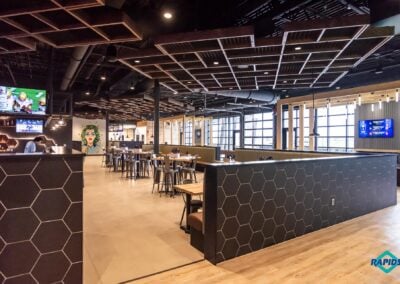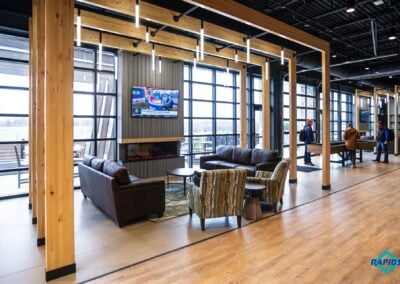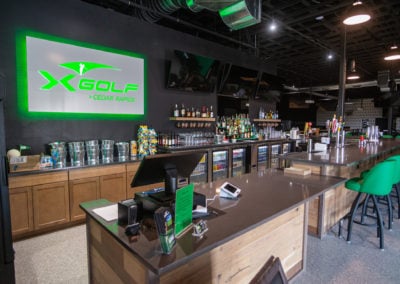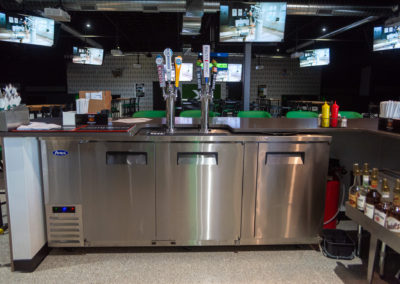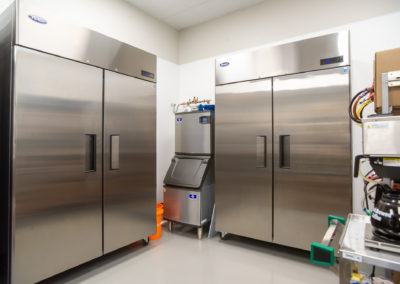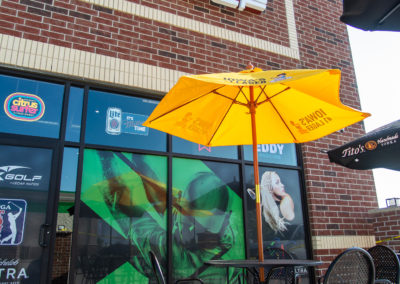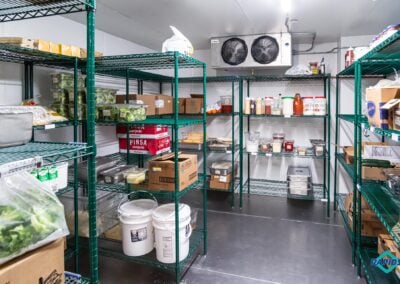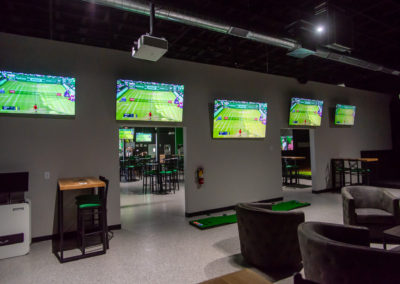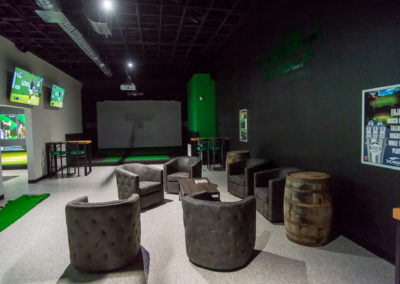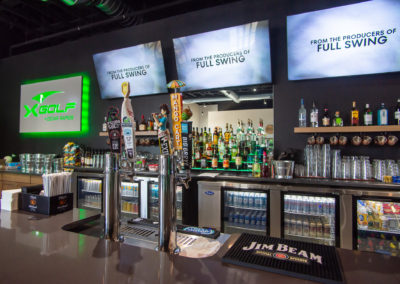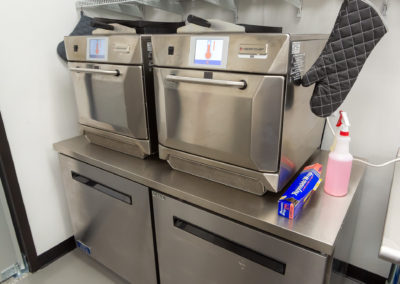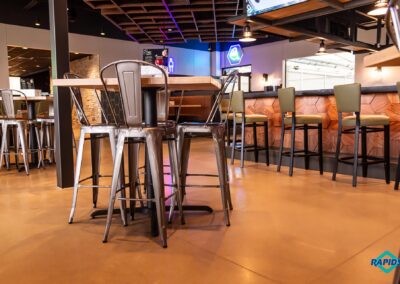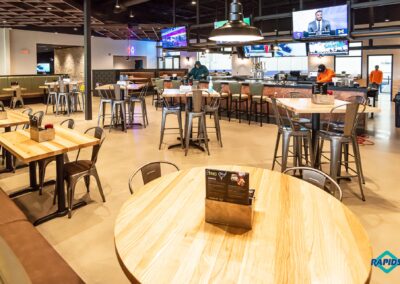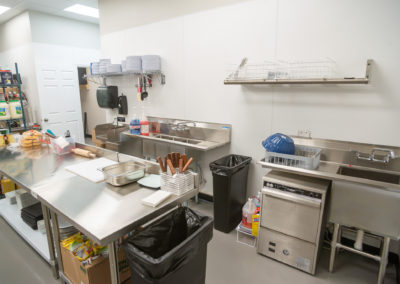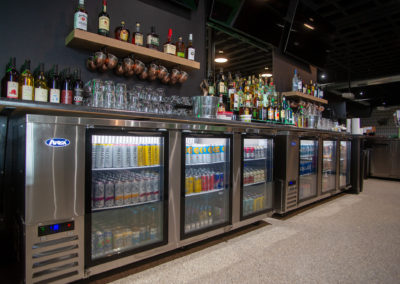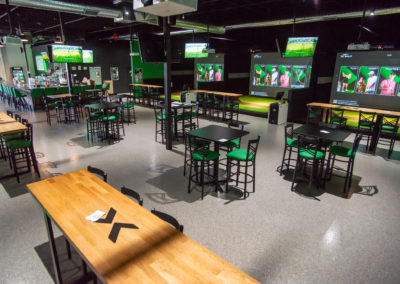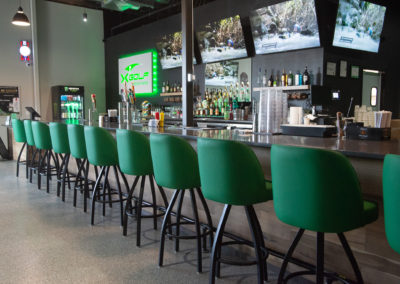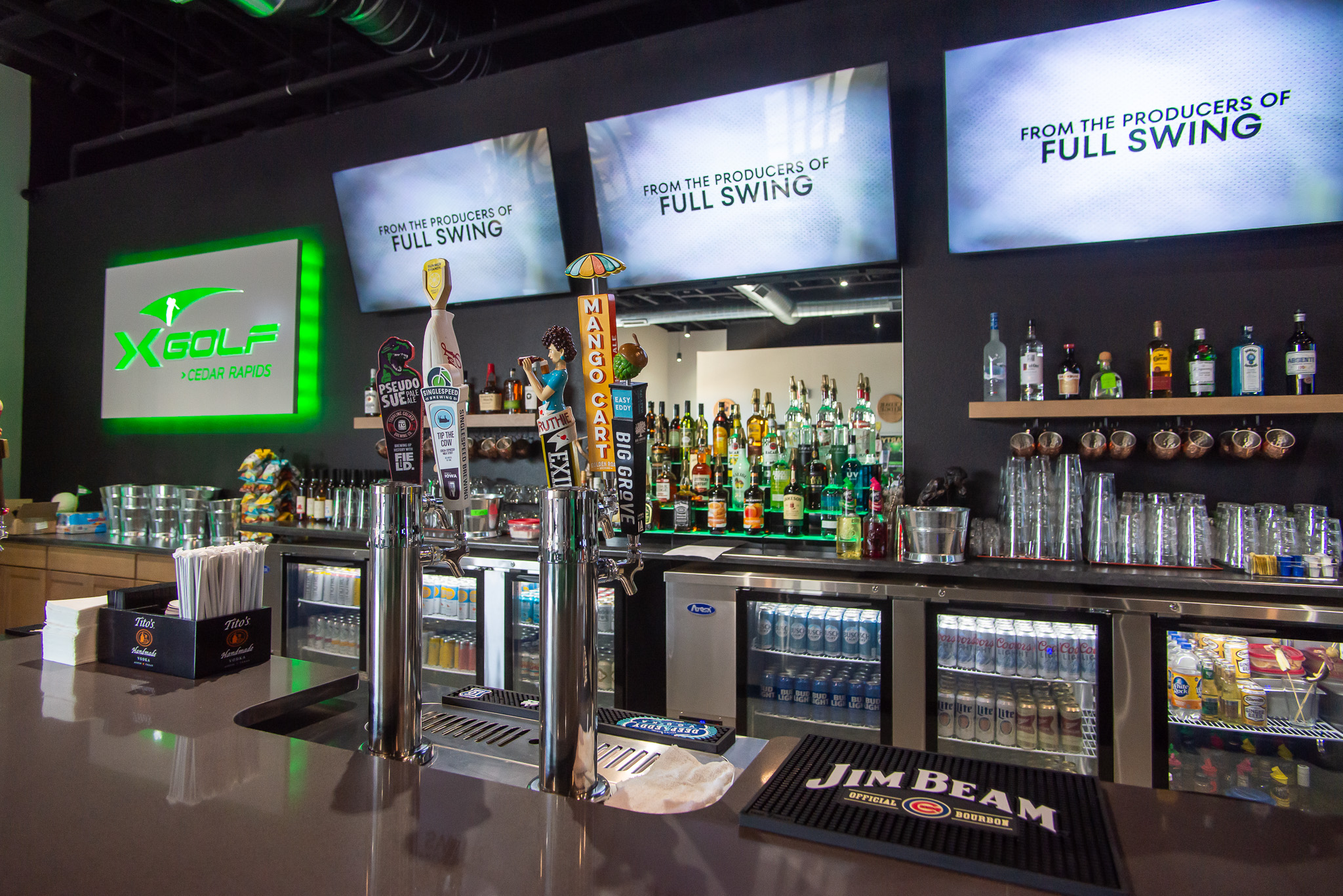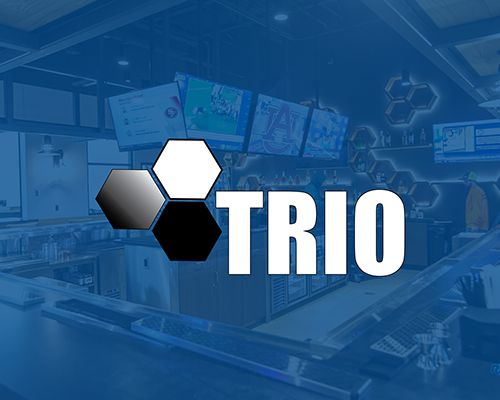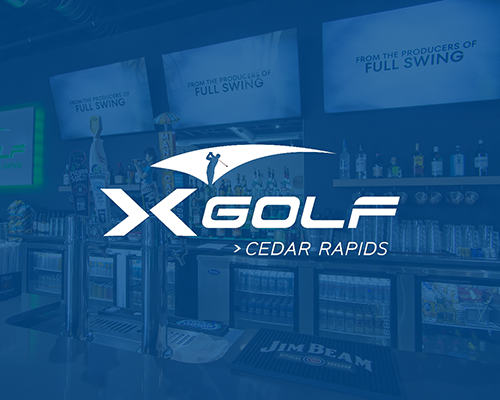Entertainment Center Design Consultants
SERVING YOUR AREA
Ready to improve or build your food service operations? Contact us to talk to one of our experts right away!
or call 800-899-6604
Efficient Dining and Engaging Entertainment Experiences
For visitors to entertainment centers, the key to satisfaction is a blend of convenience and enjoyment. Whether it’s quick-service snack bars, casual dining options, or full-service restaurants, these spaces need to provide both ease and excitement. Bars offering drinks after a movie or show, and themed dining areas, also play a role in enhancing the experience. With years of expertise, the Rapids Contract team is ready to bring innovative design to your entertainment center project, ensuring a perfect balance of service, ambiance, and guest satisfaction.
Elevating Entertainment Design for All
For every arcade, dining space, bar, and entertainment venue we design, efficiency is our primary focus. The goal is to create environments that make it easy for staff to work while ensuring guests have a comfortable experience as they enjoy food, drinks, and entertainment. Designers carefully plan layouts to optimize workflow, seating comfort, and service efficiency, ensuring a seamless experience for all.
A LEED-certified interior designer will create 3D renderings of your space, allowing you to explore the layout in detail. This gives a comprehensive view of the floor plan, budget, equipment placement, and overall design vision. Additionally, the LEED approach to entertainment spaces will help manage energy costs with energy-efficient lighting and appliances, as well as reduce waste and water consumption. This approach may also make your venue eligible for tax credits. We’re here to help your entertainment center thrive with the most efficient and sustainable solutions, meeting the needs of guests around the clock.
Get Ideas From Experts in The Industry
Track Record of Success With Major Chains
Entertainment Center Design and Implementation
Rapids Contract supports entertainment venues from the initial concept to the final touches of construction. We start with an in-depth understanding of your entertainment center’s unique requirements, whether it’s a gaming arcade, dine-in theater, or multipurpose venue. Our team oversees every detail, including vendor coordination, equipment procurement, and ensuring the project meets all compliance standards.
Discover our work with X-Golf, an innovative restaurant, bar, and golf simulator concept in Cedar Rapids. This is just one example of how we design unique and efficient spaces that elevate entertainment experiences.
Frequently Asked Questions for Entertainment Centers
How long does it take to install a entertainment center kitchen?
The time it takes to install a entertainment center kitchen can vary widely based on several factors, including the size of the kitchen, the complexity of the design, the type of equipment being installed, local regulations and permits, the availability of contractors and skilled labor, and the efficiency of the installation process.
In general, smaller and less complex kitchens in an existing foodservice space might take a few weeks to a couple of months to install, while larger and more intricate kitchens could take several months. Here are some key factors that can influence the installation timeline:
1. Design and Planning:
The design phase can significantly impact the installation time. If the kitchen’s layout and design are well-prepared in advance, it can help streamline the installation process.
2. Equipment Selection and Availability:
The type of equipment needed for the kitchen can affect the timeline. If specialized or custom equipment is required, it might take longer to source and install.
3. Permits and Regulations:
Obtaining necessary permits and complying with local regulations can sometimes be a time-consuming process that impacts the installation timeline.
4. Construction and Infrastructure:
If any modifications or construction work is required to accommodate the kitchen, such as plumbing, electrical, or ventilation systems, this can add to the installation time.
5. Skilled Labor and Contractors:
Availability of skilled contractors, electricians, plumbers, and other professionals can influence how quickly the installation can be completed.
6. Project Management:
Efficient project management can help keep the installation on track and avoid delays.
7. Unforeseen Issues:
Unexpected challenges or issues that arise during installation, such as equipment malfunctions or structural problems, can extend the timeline.
8. Size and Complexity:
Larger kitchens with more intricate setups, multiple workstations, and specialized equipment can naturally take longer to install.
9. Coordination and Scheduling:
Coordinating the various tasks involved in the installation, such as equipment delivery, construction work, and inspections, requires careful scheduling.
It’s recommended to work closely with a firm like Rapids who has solutions engineers, designers, project managers, project coordinators, and support teams experienced in commercial kitchen installations. we can provide a more accurate estimate based on the specific details of your project and help manage the process to ensure it’s completed as efficiently as possible.
How much does a entertainment center kitchen cost?
The cost of setting up a entertainment center kitchen can vary widely depending on several factors, including the size of the kitchen, the type of cuisine you’ll be preparing, the quality of equipment and materials you choose, location, and local regulations. Here are some of the major cost considerations:
1. Location:
The cost of commercial real estate can vary greatly based on the region, city, and neighborhood where you plan to set up your kitchen.
2. Size and Layout:
The overall square footage and layout of the kitchen will impact costs. A larger kitchen will require more equipment, materials, and space planning.
3. Equipment:
The cost of commercial kitchen equipment varies based on the type and brand. High-quality, specialized equipment can be more expensive. Equipment includes ovens, stoves, refrigerators, freezers, fryers, grills, ventilation systems, dishwashers, and more.
4. Ventilation and Exhaust Systems:
Proper ventilation and exhaust systems are crucial for a commercial kitchen to ensure air quality and safety. These systems can be a significant cost factor.
5. Utilities and Infrastructure:
Costs associated with plumbing, electrical work, and gas lines installation or modifications need to be considered.
6. Construction and Renovation:
If you’re building or renovating a space to accommodate the kitchen, construction costs can vary based on the extent of the work required.
7. Permits and Regulatory Compliance:
Obtaining permits and complying with health and safety regulations may incur fees.
8. Interior Design and Finishes:
The quality of finishes, such as flooring, countertops, and wall coverings, can impact costs.
9. Furniture and Fixtures:
If you’re setting up a restaurant or eatery within the kitchen space, the cost of furniture and fixtures for the dining area should also be considered.
10. Labor Costs:
Labor costs include not only the salaries of kitchen staff but also costs for installation, construction, and any specialized services needed.
11. Contingency:
It’s wise to budget for unexpected costs that may arise during the setup process.
Due to the many variables involved, it’s challenging to provide an exact figure. However, to give you a rough idea, setting up a basic small-scale commercial kitchen could start around $50,000 to $100,000. Larger, more complex kitchens with high-end equipment and finishes could cost several hundred thousand dollars or even more.
To get a more accurate estimate for your specific situation, it’s recommended to consult with our commercial kitchen design and construction professionals. We can assess your needs, provide cost breakdowns, and help you plan a budget that aligns with your goals.
What layout options are available when designing a entertainment center kitchen?
When designing a entertainment center kitchen, the layout should prioritize efficiency, speed, and safety. There are several layout options to consider, each with its own advantages depending on the size of the space, the menu, and the workflow. Here are some common layout options:
1. Assembly Line or Linear Layout:
An assembly line layout consists of different stations for each step of food preparation, making it ideal for fast food chains with a limited menu. The workflow progresses linearly from order taking to food assembly.
2. U-Shaped Layout:
A U-shaped layout places the cooking equipment and prep stations along the three sides of a U shape, with the middle left open for movement. This allows cooks to access equipment and ingredients without having to cross paths frequently.
3. L-Shaped Layout:
In an L-shaped layout, the kitchen equipment and workstations are arranged along two adjacent walls in an L configuration. This can be effective for smaller spaces and helps streamline the workflow between cooking and preparation areas.
4. Island Layout:
An island layout positions equipment and stations in the center of the kitchen, allowing cooks to access equipment from all sides. It’s suitable for larger kitchens with ample space and can provide a more flexible workflow.
5. Zoned Layout:
A zoned layout divides the kitchen into distinct areas dedicated to specific tasks, such as cooking, preparation, dishwashing, and storage. This approach is especially efficient for larger kitchens and helps prevent congestion.
6. Open Kitchen Layout:
An open kitchen layout allows customers to see the food preparation process, which can add transparency and a sense of freshness. This layout requires careful organization to maintain a clean and presentable appearance.
7. Parallel Layout:
In a parallel layout, equipment and stations are placed along two parallel lines. This is useful for kitchens with a linear workflow, where tasks progress from one end to the other.
8. Zone and Flow Layout:
The zone and flow layout combines distinct areas for different tasks while maintaining a logical progression of food preparation, ensuring a smooth workflow without unnecessary backtracking.
9. Hybrid Layout:
Depending on the specific needs of your restaurant, a combination of different layouts can be used to optimize space and workflow. For example, a U-shaped layout for cooking and an assembly line for order preparation.
Remember that the layout should be tailored to your restaurant’s unique requirements, menu items, and anticipated customer flow. It’s important to consider factors like the placement of cooking equipment, prep stations, serving areas, and storage to create a seamless and efficient kitchen environment. Consulting with Rapids‘ professional kitchen designers and solutions engineers can help you make informed decisions and create a layout that maximizes productivity and safety.
Where do you get your supplies from?
You can obtain foodservice equipment and supplies from various sources, both online and offline. Here are some common options:
Restaurant Supply Stores: These are specialized stores that offer a wide range of commercial kitchen equipment and supplies. You can find everything from cooking appliances to utensils, furniture, and cleaning supplies. Rapids currently has Restaurant Supply Store locations in St. Paul, MN and Marion, IA.
Online Retailers: There are numerous online retailers that specialize in selling foodservice equipment and supplies but clearly Rapids Wholesale’s Webstore is the best in the business!
Wholesale Distributors: Some distributors cater specifically to businesses in the food industry. They often offer bulk purchasing options and may have discounts for larger orders. Rapids Account Management Team is standing by to assist.
When sourcing foodservice equipment and supplies, consider factors like price, quality, warranty, and customer reviews. Compare options from different sources to make informed decisions that align with your budget and needs. Additionally, be aware of any local regulations or codes that might affect the type of equipment you can use in your commercial kitchen.
Previous Work – TRIO Entertainment Complex
Rapids partnered with TRIO Entertainment Complex to bring their one-stop destination for sports, dining, and entertainment to life. Featuring simulators for pickleball, golf, tennis, and soccer, along with a restaurant, bar, and a state-of-the-art movie theater with three screens, TRIO offers something for everyone.
We designed and equipped their bar, restaurant, concession, and kitchen areas with high-quality furnishings, efficient bar and concession equipment, and cutting-edge kitchen tools. Rapids is proud to support TRIO in creating a dynamic venue that combines exceptional dining, engaging entertainment, and top-tier service.
LET'S FIND YOUR SOLUTION
Rapids Contract & Design serves the United States with locations in Iowa, Minnesota, and Missouri. Our experts are ready to assist with your foodservice needs—contact us for support, Monday through Friday, 8 AM to 5 PM CST.
or call (800) 899-6604




